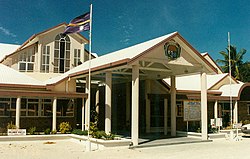| Flag | Date | Use | Description |
|---|
 | 1888–1899 | When Germany took control of the island in 1888, it was administered by German New Guinea Company, who's flag was flown in the island. [3] | A white field with the German tricolour on the canton and defaced with a black lion with a red fleur-de-lys. |
 | 1899–1914 | In 1899, the German Imperial Government took over the administration of German New Guinea through the Imperial Colonial Office, the flag of which was flown until the conquest of the colony during the First World War. [3] | A German tricolour with the coat of arms in white circle. |
 | 1919–1948 | When Nauru was still under the trustee mandate of Australia and the United Kingdom, the Union Jack was flown in the island. [3] | A superimposition of the flags of England and Scotland with the Saint Patrick's Saltire (Representing Ireland). |
 | 1942–1945 | Flag of Nauru under the occupation of the Empire of Japan during World War II. [3] | A white field with a red disc in the centre. |
 | 1948–1968 | Flag of Nauru used during Trusteeship with Australia and the United Kingdom. [3] | A Blue Ensign defaced with the seven-point Commonwealth Star in the lower hoist quarter and the five stars of the Southern Cross in the fly half. |
 | 1968–present | Current flag of Nauru adopted on 31 January 1968 following its independence from the trusteeship. [3] | A blue field with the thin yellow narrow horizontal stripe across in the centre and the large white twelve-pointed star on the bottom of the stripe and near the hoist-side. |










